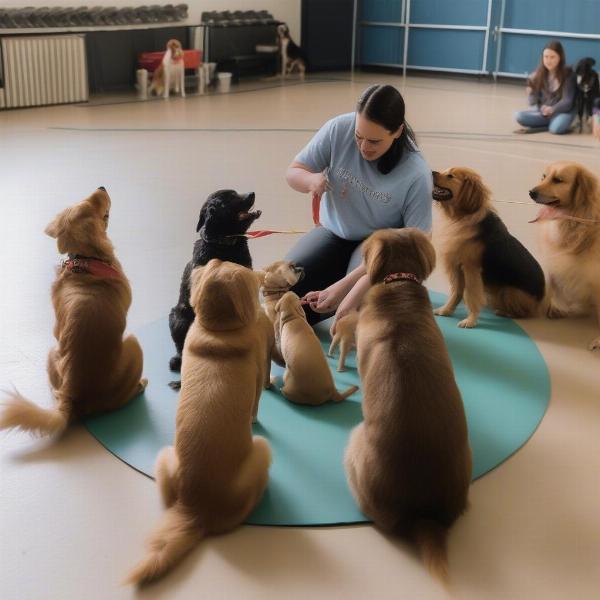Having lots of dogs can be a wonderfully rewarding experience, filling your home with love, laughter, and plenty of furry cuddles. However, managing a multi-dog household also presents unique challenges. From choosing compatible companions to ensuring everyone gets enough attention, navigating the world of “lots of dogs” requires careful planning and understanding. This article will explore the essential aspects of caring for multiple dogs, offering practical advice for both experienced and aspiring multi-dog owners.
Choosing the Right Mix: Dog Compatibility and Introductions
Introducing a new dog to an existing pack can be tricky. Careful consideration of temperament, energy levels, and size is crucial for a harmonious home. A shy, submissive dog might struggle in a household with boisterous, dominant dogs. Similarly, an energetic puppy might overwhelm an older, more relaxed canine companion. Observe your current dog’s personality and choose a potential new addition that complements, rather than clashes with, their existing dynamic.
When introducing dogs, do it gradually and in a neutral territory. Start with short, supervised interactions, gradually increasing the time spent together as they become more comfortable. Provide separate feeding areas and sleeping spaces initially to minimize competition. Be patient and understanding; building positive relationships takes time and consistency.
Feeding a Crowd: Nutritional Needs and Mealtime Management
Feeding lots of dogs presents logistical challenges. Establish a consistent feeding schedule and designated areas for each dog to prevent resource guarding and squabbles. Consider using raised feeders or slow-feed bowls, especially if some dogs tend to gobble their food quickly.
Nutritional needs vary based on age, breed, size, and activity level. Consult your veterinarian to determine the appropriate diet for each dog in your pack. Ensure everyone receives the correct portion sizes to maintain a healthy weight and prevent obesity.
Training and Behavior: Managing a Pack Dynamic
Training multiple dogs requires a slightly different approach than training a single dog. Consistency and clear communication are paramount. Establish clear rules and boundaries for the entire pack, ensuring each dog understands their place in the hierarchy.
 Group Dog Training Session
Group Dog Training Session
Focus on individual training sessions to address specific behavioral issues or reinforce desired commands. Group training sessions can be beneficial for socializing and practicing basic obedience, but always be mindful of individual personalities and potential distractions.
Health and Wellness: Veterinary Care for Multiple Dogs
Maintaining the health of lots of dogs can be demanding, both financially and logistically. Regular veterinary checkups, vaccinations, and parasite prevention are essential for every dog. Keep accurate records for each individual, noting any allergies, medical conditions, or medications.
Observe each dog carefully for any changes in behavior, appetite, or energy levels. Early detection of potential health issues is crucial for effective treatment.
Conclusion: The Joys and Challenges of Multi-Dog Households
Sharing your life with lots of dogs can be an incredibly enriching experience. However, responsible multi-dog ownership requires dedication, planning, and a deep understanding of canine behavior. By prioritizing compatibility, managing resources effectively, and providing consistent training and care, you can create a harmonious and happy home for your furry family. Remember to enjoy the unique bond that comes with having a pack of loving companions.
FAQ:
- How many dogs are considered “lots of dogs”? There’s no magic number, but generally, four or more dogs are considered a multi-dog household, posing more significant management challenges.
- Is it more expensive to have lots of dogs? Absolutely. Food, veterinary care, toys, and other supplies multiply with each additional dog.
- How do I prevent fights between my dogs? Careful introductions, resource management, and consistent training are key to preventing conflict.
- What if my dogs don’t get along? Consult a certified dog trainer or behaviorist for professional guidance.
- Can I travel with lots of dogs? It’s possible, but requires careful planning and consideration of each dog’s needs.
- How do I ensure each dog gets enough attention? Schedule individual playtime and training sessions to bond with each dog separately.
- What are the legal implications of owning lots of dogs? Check local ordinances regarding pet ownership limits and licensing requirements.
ILM Dog is a leading international online resource for dog care and training. We offer expert advice on everything from breed selection and puppy care to senior dog health and behavioral issues. Our goal is to empower dog owners with the knowledge and resources they need to provide the best possible care for their canine companions. Whether you have one dog or lots of dogs, we’re here to help. Contact us at [email protected] or +44 20-3965-8624 for personalized guidance. ILM Dog offers comprehensive services in dog breeds, health, training, nutrition, grooming, and accessories to help you navigate the joys and challenges of dog ownership.